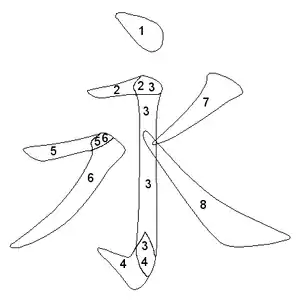Eight Principles of Yong
The Eight Principles of Yong are used by calligraphers to practice how to write the eight most common strokes in regular script, using the fact that they are all present in the character 永; yǒng; 'forever'', 'permanence'. It was believed that the frequent practice of these principles as such when beginning one's study could ensure beauty in the Chinese calligrapher's writing.
  The character 永; yǒng; 'forever'', 'permanence': its stroke order animated (left) and colored sequentially from black to red (right) | |
 The strokes numbered: where there are multiple numbers in an area, the strokes overlap briefly and continue from the previous number to the next. | |
 The strokes together and separated: sequence numbers, and stroke directions (red) |
| Eight Principles of Yong | |||||||||||||||||||||
|---|---|---|---|---|---|---|---|---|---|---|---|---|---|---|---|---|---|---|---|---|---|
| Chinese name | |||||||||||||||||||||
| Chinese | 永字八法 | ||||||||||||||||||||
| |||||||||||||||||||||
| Vietnamese name | |||||||||||||||||||||
| Vietnamese alphabet | Vĩnh tự bát pháp | ||||||||||||||||||||
| Chữ Hán | 永字八法 | ||||||||||||||||||||
| Korean name | |||||||||||||||||||||
| Hangul | 영자팔법 | ||||||||||||||||||||
| Hanja | 永字八法 | ||||||||||||||||||||
| |||||||||||||||||||||
| Japanese name | |||||||||||||||||||||
| Kanji | 永字八法 | ||||||||||||||||||||
| Kana | えいじはっぽう | ||||||||||||||||||||
| |||||||||||||||||||||
The Eight Principles are influenced by the Eastern Jin-era Seven Powers (七勢) by Lady Wei Shuo. Publications on the principles include:
- The Tang-era Praise to the Eight Principles of "Yong" (永字八法頌) by Liu Zongyuan[1]
- The Tang-era Praise to the Eight Principles of "Yong" (永字八法頌) by Yan Zhenqing[2]
- The Yuan-era Eight Ways to Explain "Yong" (永字八法解) by Li Puguang,[3] which provides two-character metaphorical names
Table
| Stroke[4] | Name | Additional description | |||||
|---|---|---|---|---|---|---|---|
| Tang-era[1][2] | Li[3] | CJK stroke | Vietnamese | ||||
| 1 | ㇔ |
側; 侧; cè; 'side' | 怪石; guàishí; 'dot' | 點; 点; diǎn; 'dot' | Nét chấm | Tiny dash, speck | |
| 2 | ㇐ |
勒; lè; 'bridle' | 玉案; yù'àn; 'jade table' | 橫; 横; héng; 'horizontal' | Nét sổ ngang | Rightward | |
| 3 | ㇑ |
|
鐵柱; 铁柱; tiězhù; 'iron pillar' |
|
Nét sổ dọc | Downward | |
| 4 | ㇚ |
趯; tì; 'jump' | 蟹爪; xièzhuǎ; 'crab's pincer' | 鉤、鈎; 钩; gōu; 'hook' | Nét móc | Appended to others, suddenly going down, or left only | |
| 5 | ㇀ |
策; cè; 'horsewhip' | 虎牙; hǔyá; 'tiger's tooth' |
|
Nét hất | Flick up and rightwards | |
| 6 | ㇁ |
掠; lüè; 'skim' | 犀角; xījiǎo; 'rhinoceros's horn' | 彎; 弯; wān; 'curve' | Nét cong | Tapering thinning curve, usually concave left (convex outward right) with fast speed as if skimming | |
| 7 | ㇒ |
啄; zhuó; 'to peck' | 鳥啄; 鸟啄; niǎozhuó; 'bird's pecking' |
|
Nét phẩy | Falling leftwards with light curve | |
| 8 | ㇏ |
磔; zhé; 'dismember' | 金刀; jīndāo; 'golden knife' |
|
Nét mác | Falling rightwards, fattening at bottom, where endpoint is "sharp as a knife" | |
CJK strokes
In addition to these eight common strokes in 永, there are at least two dozen strokes of combinations which enter in the composition of CJK strokes and by inclusion the CJK characters themselves. Many are included in Unicode.[4]

The principles, as shown in the Vietnamese book 日用常談 Nhật dụng thường đàm
See also
References
- Liu, Zongyuan. 永字八法颁 Yǒngzìbāfǎ sòng [Praise to the Eight Principles of "Yong"]. 全唐文 (in Chinese). Vol. 0583.
- Yan, Zhenqing. 永字八法颂 Yǒngzìbāfǎ sòng [Praise to the Eight Principles of "Yong"]. 全唐文 (in Chinese). Vol. 0338.
- Li, Puguang. 永字八法解 Yǒngzìbāfǎ jiě [Eight Ways to Explain "Yong"] (in Chinese).
- "CJK Strokes" (PDF). The Unicode Standard.
This article is issued from Wikipedia. The text is licensed under Creative Commons - Attribution - Sharealike. Additional terms may apply for the media files.